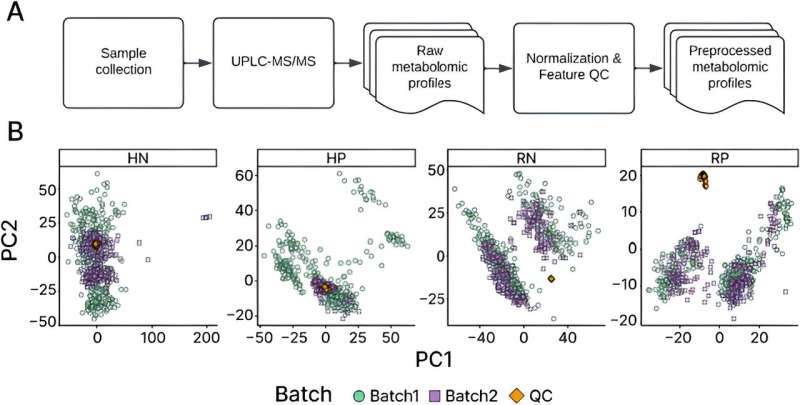This article has been reviewed according to Science X's editorial process and policies. Editors have highlighted the following attributes while ensuring the content's credibility:
fact-checked
peer-reviewed publication
trusted source
proofread
Researchers leverage AI to develop early diagnostic test for ovarian cancer

For more than three decades, a highly accurate early diagnostic test for ovarian cancer has eluded physicians. Now, scientists in the Georgia Tech Integrated Cancer Research Center (ICRC) have combined machine learning with information on blood metabolites to develop a new test able to detect ovarian cancer with 93% accuracy among samples from the team's study group.
The team's results and methodologies are detailed in a new paper published in the journal Gynecologic Oncology.
John McDonald, professor emeritus in the School of Biological Sciences, founding director of the ICRC, and the study's corresponding author, explains that the new test's accuracy is better in detecting ovarian cancer than existing tests for women clinically classified as normal, with a particular improvement in detecting early-stage ovarian disease in that cohort.
Based on their computer models, the researchers have developed what they believe will be a more clinically useful approach to ovarian cancer diagnosis—whereby a patient's individual metabolic profile can be used to assign a more accurate probability of the presence or absence of the disease.
"This personalized, probabilistic approach to cancer diagnostics is more clinically informative and accurate than traditional binary (yes/no) tests," McDonald says. "It represents a promising new direction in the early detection of ovarian cancer, and perhaps other cancers as well."
Silent killer
Ovarian cancer is often referred to as the silent killer because the disease is typically asymptomatic when it first arises—and is usually not detected until later stages of development, when it is difficult to treat. While the average five-year survival rate for late-stage ovarian cancer patients, even after treatment, is around 31%, McDonald explains that if ovarian cancer is detected and treated early, the average five-year survival rate is more than 90%.
"Clearly, there is a tremendous need for an accurate early diagnostic test for this insidious disease," McDonald says.
And although development of an early detection test for ovarian cancer has been vigorously pursued for more than three decades, the development of early, accurate diagnostic tests has proven elusive. Because cancer begins on the molecular level, McDonald explains, there are multiple possible pathways capable of leading to even the same cancer type.
"Because of this high-level molecular heterogeneity among patients, the identification of a single universal diagnostic biomarker of ovarian cancer has not been possible," McDonald says. "For this reason, we opted to use a branch of artificial intelligence—machine learning—to develop an alternative probabilistic approach to the challenge of ovarian cancer diagnostics."
Metabolic profiles
Georgia Tech co-author Dongjo Ban, whose thesis research contributed to the study, explains that "because end-point changes on the metabolic level are known to be reflective of underlying changes operating collectively on multiple molecular levels, we chose metabolic profiles as the backbone of our analysis."
"The set of human metabolites is a collective measure of the health of cells," adds co-author Jeffrey Skolnick, "and by not arbitrarily choosing any subset in advance, one lets the artificial intelligence figure out which are the key players for a given individual."
Mass spectrometry can identify the presence of metabolites in the blood by detecting their mass and charge signatures. However, Ban says, the precise chemical makeup of a metabolite requires much more extensive characterization.
Ban explains that because the precise chemical composition of less than 7% of the metabolites circulating in human blood have, thus far, been chemically characterized, it is currently impossible to accurately pinpoint the specific molecular processes contributing to an individual's metabolic profile.
However, the research team recognized that even without knowing the precise chemical make-up of each individual metabolite, the mere presence of different metabolites in the blood of different individuals, as detected by mass spectrometry, can be incorporated as features in the building of accurate machine learning-based predictive models (similar to the use of individual facial features in the building of facial pattern recognition algorithms).
"Thousands of metabolites are known to be circulating in the human bloodstream, and they can be readily and accurately detected by mass spectrometry and combined with machine learning to establish an accurate ovarian cancer diagnostic," Ban says.
A new probabilistic approach
The researchers developed their integrative approach by combining metabolomic profiles and machine learning-based classifiers to establish a diagnostic test with 93% accuracy when tested on 564 women from Georgia, North Carolina, Philadelphia and Western Canada. Of the study participants, 431 were active ovarian cancer patients, while the remaining 133 women in the study did not have ovarian cancer.
Further studies have been initiated to study the possibility that the test is able to detect very early-stage disease in women displaying no clinical symptoms, McDonald says.
McDonald anticipates a clinical future where a person with a metabolic profile that falls within a score range that makes cancer highly unlikely would only require yearly monitoring. But someone with a metabolic score that lies in a range where a majority (say, 90%) have previously been diagnosed with ovarian cancer would likely be monitored more frequently—or perhaps immediately referred for advanced screening.
More information: Dongjo Ban et al, A personalized probabilistic approach to ovarian cancer diagnostics, Gynecologic Oncology (2024). DOI: 10.1016/j.ygyno.2023.12.030




















